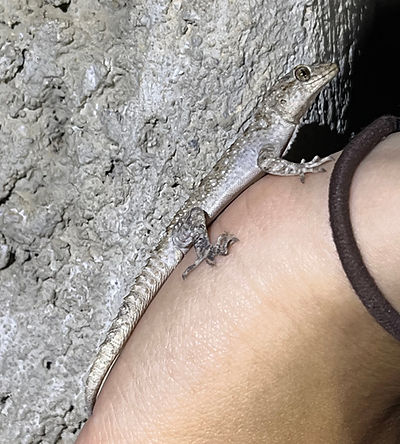RESEARCH



RESEARCH INTERESTS
We are broadly interested in the ecology, evolution, and behavior of reptiles and amphibians - especially on islands and in cities ! We study how spatial and temporal changes in ecology and environment influence lizard behavior, morphology, physiology, genetic variation, and biological diversity across biological scales, from genes to species. The lab is especially interested in the effects of urbanization and microclimate change on herptile evolution.
What are the effects of urbanization on thermoregulatory and anti-predator behavior? How will herptiles adapt to rapid human landscape modification and microclimate change? Are certain phenotypes primed for life in the city?
Research in the lab is integrative. We use a combination of large-scale field studies, laboratory experiments, and phylogenetic comparative analyses on populations and species of herps. Our work largely takes place in locations with Mediterranean climates such as Greece, Italy, and Southern California. Not bad !

Measuring wall lizards from Naxos, Greece
CURRENT RESEARCH
WALLIE WORLD: ITALIAN WALL LIZARDS IN THE USA


Several species of Podarcis lizards have repeatedly established thriving populations from introductions of a few individuals all over North American cities from New York to San Diego, often displacing native species. In San Diego and Los Angeles, introduced Italian wall lizards (Podarcis siculus) have established expanding populations that actively exclude native Western fence lizards (Sceloporus occidentalis). How do a couple of lizards from Italy explode into huge populations and push out native species that have been evolving in these places for millennia? Does Podarcis' long evolutionary history with humans give them a leg up for co-existing in cities with us? Having an understanding of the genetic, environmental, behavioral, and ecological properties of successful species invasions in cities provides insights into urban evolution and how species deal with sudden environmental change more broadly.
Our goal is to unravel the genomic and phenotypic pathways to repeated success in novel urban environments by comparing the genetics, morphology, and performance of introduced wallies across North America.
This work is in collaboration with Dr. Greg Pauly at the LA County Museum of Natural History, Dr. Bree Putman at Cal State San Bernardino, Dr. Eric Gangloff at Ohio Wesleyan University, Dr. Douglas Eifler at The Erell Institute, Dr. Peter Bednekoff at Eastern Michigan University, and Dr. Giulia Simbula at the Research Centre in Biodiversity and Genetic Resources in Porto, Portugal.
URBAN SNAKE MOVEMENT, BEHAVIOR, AND LANDSCAPE GENETICS

Snakes are among the most mysterious and elusive creatures, often hidden in plain sight and rarely seen—especially in urban areas where their secretive nature makes them difficult to detect. Their stealthy movements, cryptic coloration, and tendency to avoid human contact contribute to their near invisibility in cityscapes. Yet, as urbanization encroaches on natural habitats, understanding how snakes navigate and survive in these fragmented environments becomes critical. Research on their movement patterns, behavior, and landscape genetics within urbanized settings is essential for informing conservation strategies. Such studies reveal how urban features influence gene flow, habitat use, and survival, helping scientists design better corridors, mitigate human-wildlife conflict, and preserve biodiversity. Without targeted research, many snake populations may decline unnoticed, further eroding urban ecosystem health and missing key opportunities to coexist with these important, often misunderstood reptiles.
Dr. Rulon Clark and I are researching how urbanization influences snake movement, behavior, and connectivity across San Diego County. We are currently recruiting a PhD student to coadvise on this project, but everyone in SD County can participate. See a snake? Let us know!
CONVERGENT ADAPTATION TO CITIES

Changing Landscapes, Changing Tactics: The Impact of Novel Environments on Gecko Defense Strategies. Geckos from the Mediterranean region have repeatedly established populations from a few introduced individuals in cities around the world. Do these geckos have similar morphological and behavioral syndromes in cities where they are native? And what about in cities where they have been introduced, such as Los Angeles and San Diego? We are interested in how cities shape gecko defense traits in different cities around the world. Our goal is to understand genomic and phenotypic factors that influence their success in densely populated human-dominated environments.
This research is in collaboration with Dr. Panayiotis Pafilis (University of Athens, Greece) and Dr. Yuval Itescu (Haifa University, Israel).
TRAIT DIFFERENCES AMONG COLOR MORPHS IN WALLIES
Color polymorphisms offer a great opportunity to study how phenotypic variation is generated, maintained, and lost in natural populations. Check out some of our published work on color morph trait differences in Aegean wall lizards (Podarcis erhardii) and introduced Common wall lizards (P. muralis). Our findings suggest that morph colors are related to differences in traits that are crucial for social interactions and competitive ability, illustrating the need to look beyond color when studying polymorphism evolution.
Read our paper on morph color, size, bite force, and chemical signal profiles in PeerJ
Read our paper on differential body temperature preferences between P. erhardii color morphs on bioRxiv
Read our paper on morph differences in habitat use and ectoparasite loads in Amphibia-Reptilia
Read our paper on morph-correlated social behaviors and contest abilities in Animal Behaviour !
Read our paper on differences in color morph escape behavior in Behavioral Ecology & Sociobiology

RESEARCH FUNDING
Herpin' ain't easy, but it's necessary. Collecting genetic, phenotypic, and environmental data from the field is critical to advance our understanding of nature and conserving reptiles (and all biodiversity!) in a rapidly changing world. Thanks very much to the organizations that have funded TeamSavres research over the years.









